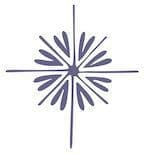Now let’s look at consciousness from a different angle. We humans have a hard time understanding that consciousness is something that permeates all of creation. Our human minds are geared to think of it as being exclusively related to the human form, associated with the brain and a byproduct of our personality. This is not so.
Consciousness does not need to be attached to a fixed form, so it’s everywhere. It’s also in everything, including of course every particle of matter. In inanimate matter, consciousness is solidified, the same way energy is petrified in an inanimate object. These two things—consciousness and energy—are not the same thing, but rather related aspects of manifestations of life.
As evolution follows its course, energy and consciousness become more and more mobile and vibrant, so things move faster. In the case of consciousness, it gains in awareness. For energy, it gains greater creativity to make forms and move about.
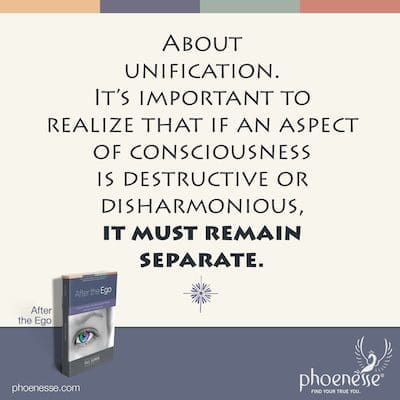
Over much time, consciousness has gone through separation. The process by which this has happened is impossible to spell out with words. The result though is that aspects of consciousness now float around in the universe, so to speak. Every trait we can think of, every attitude known to mankind, every personality trait we can imagine is a manifestation of consciousness. And each particle of consciousness that is not yet integrated in the whole needs to be synthesized and unified with all that is, to create one harmonious whole.
We’ll need to use our imaginations here to be able to follow along. For example, can we imagine that some familiar personality trait could exist separate from a person? That a trait is not the person per se, but a free-floating particle of overall consciousness?
It doesn’t matter if the trait is good or evil. It could be any of these: love, perseverance, laziness, impatience, sloth, stubbornness, kindness or malice. Each must be incorporated into manifesting personalities. For that’s the only way for each to be harmonized and purified, enriching the consciousness that’s manifesting and creating the conditions for the unification of consciousness as evolution unfolds.
About unification. It’s important to realize that if an aspect of consciousness is destructive or disharmonious, it must remain separate. Any person who has done their own personal work can verify this. Positive traits, which are the constructive parts of consciousness, are a harmonious piece of the pie. They enrich the whole and expand the entire unified field. The limits of human language prevent going further in trying to explain this, and at any rate, this teaching will benefit us most if the information is practical and not abstract.
Each aspect of consciousness has its own unique characteristics, such as vibrating at a certain rate, according to its nature. This is true for those we can detect with our five senses, as well as for many other sensory expressions we aren’t able to perceive. For there are infinitely more colors, scents and tones than we know anything about.
Humans are a conglomeration of many, many aspects of consciousness. Some have always been pure, others have already been purified, and still other aspects are negative and destructive, and therefore separate, like appendages. Our task, when we incarnate, is to transform these isolated aspects and merge them into various aspects of consciousness. What a novel way to explain human existence!
This applies to humanity and also to other higher levels of consciousness where the struggle is not so painful or severe. Becoming aware that there are higher states can aid us in the work we need to do here. Our predicament is that we generally lack an understanding of what’s going on here. We’re blind about the struggles we get locked into, and this causes us to only make matters worse.
To whatever degree there is tension and struggle within a person, to that degree the various aspects of consciousness are at odds with each other. We flail about, trying to identify with one aspect or another, unaware of what this struggle is about. Going blindly through this maze, we’re also unaware what our Real Self is, where it’s located and how to find it in the midst of this muddle.
We’re unsure if we are our best qualities, or if perhaps we’re the strict conscience that berates us for our negative traits. Or are we maybe the destructive demon that’s hiding inside? Which part is our best self? Is it our rage at this demon? Or the part that pretends the demon doesn’t exist? Whether we know it or not, this kind of search is going on inside us. And it’s better if we can become more conscious that this struggle exists. Any path of self-knowing is going to sooner or later need to grapple with these questions. For fundamentally, it’s a problem of self-identity. Who are we, really?
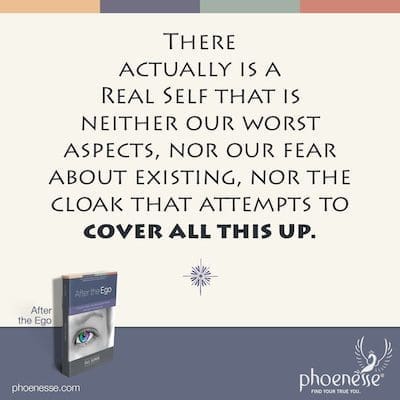
Who am I?
It’s a problem that humans identify with any of the aspects we’ve mentioned at all. For we are not our negative traits, and we are also not the conscience that punishes us for them. We’re not even our positive traits. Despite the fact that we’ve managed to integrate the positive parts into the whole of our being, that’s not the same thing as identifying with them. It would be more correct to say this: I am the part which managed this integration by sorting, deciding, thinking, acting and willing. This is what allowed me to absorb into myself the aspects that were previously an appendage.
Each aspect of consciousness that we work to heal and absorb has a will of its own. If we have gotten started on a path of self-healing, we’re probably aware of this by now. If we are blindly struggling and getting lost, we will be controlled by each of these various aspects because we haven’t yet found our Real Self. Once we identify differently with our Real Self, we will find our power. Our blind involvement ensnarls us and pulls the plug on our creative energy. Our missing sense of self leads us to feelings of despair.
If, in our blindness, we mistakenly believe that we are only our destructive parts, we become tangled up in a special kind of inner battle. On one hand, we’ll react with violent self-hate, self-punishment and self-annihilation. On the other hand, since we believe we are these negative traits, how can we ever want to give them up? Why even face them and try to figure them out?
Back and forth we are tossed between “I must remain as I am, unchanging and unimproved, for this is who I am and I don’t want to stop existing,” and “I am so terrible, I have no right to exist; I should punish myself right out of existence.” If we believe this conflict to be real, how can we bear to face it? So we put the whole mess to sleep.
Then we go about life, living “as if.” By pretending, we shift our identify to our mask. Now our struggle is to not expose the false pretense we’re living under. And give up the pretense? Never. For the alternative is to dive back into that painful struggle. No wonder we have so much resistance! And yet, this is all such a waste. For none of it is even the true reality. There actually is a Real Self that is neither our worst aspects, nor our fear about existing, nor the cloak that attempts to cover all this up. Our main concern: We must find that Real Self.
Work with what we can
Before our Real Self can manifest fully, there is already a part of it that is readily available to us right now. This is our conscious self at its best, as it is in this moment. It may only be a limited part of our greater being, but it is us. This is the “I” that needs to start making order out of all our confusion. It actually already shows up in many areas of our life, but we take it for granted. And to-date, we haven’t yet brought it to bear on this situation where we’re blindly controlled by a false identity and the consequences that result from this.
It is safe to identify with the “I” that is able to make a decision to truly face this conflict. This is the part of us that is able to observe what’s going on. And to the degree we wake up and gain a higher degree of self-consciousness, we can make decisions and choose our attitude. We can also turn this around and say that to the degree we make certain decisions and choose particular attitudes, our consciousness will awaken and expand.
Most people fail to put this part of consciousness that’s immediately available to them to good use, using it where they experience the greatest suffering and conflict. We don’t realize how much power this part of us has to help us sort out this problem of identity. But once we start to systematically do this, a major change is going to take place in our lives. When that happens, we’ll reach a new stage in our development.
We can lean on our already existing knowledge of truth. And we can rely on our ability to act with good will. We can call upon our capacity to be positive, courageous and committed in this struggle to find our identity. And we can choose how to proceed in dealing with this problem. To the exact degree we do these things, our consciousness will expand and become increasingly infused by spiritual consciousness.
If we aren’t putting the consciousness we already can access to use in the way we conduct our lives, then spiritual consciousness is not going to manifest through us. But if we apply our existing consciousness, then new inspirations and understandings of profound wisdom will well up from the depths of our being.
But if we keep following the line of least resistance, giving in to blind involvement and giving up on discovering our true identity, we will settle for a sorry existence and remain stuck in the old rut of reacting out of habit and then justifying our bad behavior. If we keep indulging in compulsive behaviors and getting lost in hopeless, negative thinking, we’ll keep spinning in our unhappiness. Then our present consciousness can’t be put to use.
As a result, our consciousness won’t expand one iota. Nor will it transmute and synthesize those negative traits it now falsely identifies with. From here, we can’t bring in any deeper values, not if we won’t work with the values already available to us. This is a spiritual law of life that applies on every level of our beings. We should not take this lightly.
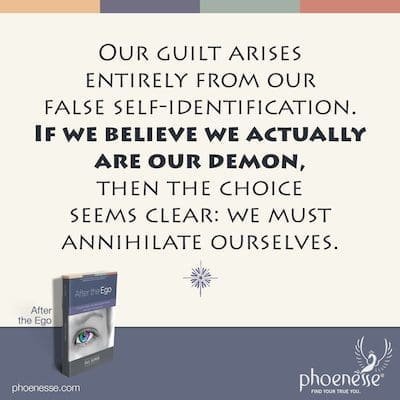
What area do we identify with?
Many of these teachings talk about the Higher Self, the Lower Self and the Mask Self. These three abbreviated terms actually cover a lot of ground, as each comprises many variations and subdivisions. For our convenience, we can classify certain aspects of consciousness according to which category it belongs in. Therefore, when we identify with a particular aspect or cluster of aspects, we will become submerged in that area of the self.
For example, one expression of the Higher Self is good will. But we have another will for good that is not an aspect of the Higher Self, and we can easily confuse the two. They are, however, by no means the same. The second version is our will to be good for the sake of appearances. Here, we use our goodness to serve denying our badness, or Lower Self. We do this when the conscious part of us that decides and chooses doesn’t want to take on the challenge of confronting our negative aspects.
Our destructive aspects—the demoniacal parts of us—are obviously at home in our Lower Self. So then how about the enormous guilt we feel about our destructive aspects that threatens to punish and even annihilate us over our Lower Self aspects—surely that’s an expression of our Higher Self, right? No, it’s not, although it easily poses for it. In fact, our guilt is more destructive than our destructiveness itself.
Our guilt arises entirely from our false self-identification. If we believe we actually are our demon, then the choice seems clear: we must annihilate ourselves. But we dread annihilation, which leaves us holding on to our demon. But if we will observe the demon, now we’ve taken a tiny little step. This is just far enough for us to start identifying with the part of us that observes.
Don’t forget, none of us are completely swallowed up by this struggle. If that were the case, we’d have no hope of ever getting out of it. So our negative aspects aren’t all of us. We can find many aspects of our beings where we use the power of our creative thinking, expanding our mind and as a result, build something productive. But let’s stay focused on those areas that aren’t so shiny, where we aren’t being productive or expansive.
As long as we are unable—or more aptly, unwilling—to notice our destructive bits, we’ll be lost in them. From there, it’s not possible to achieve proper self-identification. And although our desire to hide our destructiveness is worse than what we’re hiding, it at least shows that we desire to be done with our destructiveness. As such, our desire to hide the destructiveness of our Lower Self is a misplaced, misread and misunderstood message coming from our Higher Self, which longs for freedom. So it’s a wrong way of interpreting the longing of our Real Self and a wrong way of applying a solution.
Our task
Let’s return to the part of us that observes. It’s time to see how we can better activate and utilize our conscious self. For we want to expand this aspect of ourselves, making room for universal consciousness to infiltrate it.
When we are first starting out on our spiritual path, our work is to disassemble our mask by giving up our defenses. We must also overcome our resistance to exposing our shameful faults. Oddly, what we experience is that acknowledging our negative traits brings a new freedom. Why is this so? The obvious answer is that by merely having the courage and honesty to see ourselves in truth is liberating. It creates much-desired relief. But it’s also more than that.
When we acknowledge a part of ourselves that is destructive, a very subtle yet distinct shift occurs in our identification. Before this, we were blindly acting out our destructiveness so we were helplessly controlled by these aspects. This is an indication that we believed them to be who we are.
Because we identified with them, we couldn’t afford to acknowledge them. After all, they are unacceptable. But the moment we see what was previously unacceptable, we stop being unacceptable. Now we’ve become identified with the part of us that can and does decide to take a look.
Then, another part of us takes over that can actually do something about them. Starting out, this may only be to observe them and grope for an understanding of why they are here. But we are now in a totally different situation than before when we identified with the ugly traits.
The instant we identify them, we stop being identified with them. This is why it frees us just to acknowledge the worst parts of our personality after eons of battling with our resistance to see our current selves in truth. Once we make this clear distinction, it will become easier and easier to become more and more aware of ourselves, as we are right now.
When we do this—spot, watch and clearly describe what our destructive aspects are up to now—we will have found our Real Self with which we can safely identify. From here, we have lots of options, the most important right now being this ability to identify, observe and articulate. Doing so will dismantle our self-hate. But as long as we neglect this all-important process of identifying with our Real Self, there seems to be no way to avoid hating ourselves.
The power that we have now tapped into has additional capabilities. It can recognize and adopt new attitudes that are free from the self-judgment that feels so devastating. This part has the ability to judge negativity in a truthful way. But there’s a world of difference between this kind of helpful critique and believing that what we judge is the truth of who we are. It’s helpful to realize that this part of ourselves—the part that acknowledges our destructiveness—has other options available to it, making it much closer to our ultimate reality.
Notice how different it feels to realize that the task of being human is to carry negative aspects with us for the purpose of transforming them and re-integrating them with the whole. This perspective makes space for truthfulness without feeling hopeless. Notice how dignifying it feels to consider that we are undertaking this important task for the sake of evolution!
So when we arrive into this world, we bring negative aspects along with us. There are meaningful laws that determine which aspects we will bring, but every person fulfills an immense task by doing this work. Someone who doesn’t offer to do this kind of work may, indeed, be quite purified already, and therefore relatively harmonious and evolved. But they are not contributing to universal evolution the way we are when we do this work of self-realization. Our task gives us a reason to feel great dignity, which outweighs the momentary suffering that accumulates from the fact that we’ve lost sight of who we truly are.
When we deal with the realms beyond duality, we routinely bump into apparent contradictions. This is just what happens when we approach ultimate reality. One of these is this: We must acknowledge our ugly aspects as being part of who we are, and take responsibility for them, before we can truly understand that this is not who we are. It’s entirely possible to be responsible for them and not believe they are our only reality.
Only when we take responsibility for them do we come to this wonderful realization that we are not them. Rather, we are carrying something in us which we are willing to take responsibility of, for the purpose of evolution. Once we’ve taken this important step, we are ready for the next step: integration.
So to recap the steps we’ve taken so far:
- We are half-asleep, living in a climate of not knowing who we are and blindly battling against everything we hate about ourselves, consciously, semi-consciously and unconsciously.
- Then we start to wake up, observing and speaking clearly about what we don’t like. We can feel now that this is just an aspect of us, and not the secret ultimate truth about who we are.
- More and more, we are the “I” that observes, and we become aware that we can make new choices. We will discover options and possibilities we never dreamed of before, not by magic but by trying out ways of being we ignored before. Such new attitudes might include: self-acceptance that doesn’t blow things out of proportion; learning from our missteps; perseverance to keep going, even when we don’t have instant success; begin to have faith in the unknown potentials that will surface only when we adopt such winning attitudes.
After we have begun adopting such new ways of perceiving ourselves, we will be able to move on to the fourth and final step:
- We will comprehend the reason for our negative, destructive aspects, and this will dissolve them so they can be re-integrated.
As our consciousness expands and merges with universal consciousness, spiritual reality can unfold even more. This is what it means to purify ourselves. To the extent we do this, leading our lives in such a way, the overall consciousness of the universe becomes less split off into separate particles. This is how we all work together to reach unification.
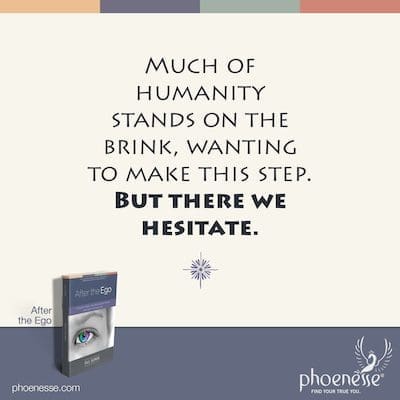
Taking the next step
When we consider everything just said, we will understand several important things. For starters, we will see how important it is that we recognize our demonic traits which are based on a distortion of truth. We will take responsibility for these destructive aspects of ourselves which, paradoxically, will free us from identifying with them. We will fully know who we are and see that the negative parts are just appendages, which we can re-incorporate into ourselves as we dissolve them. In doing so, their basic nature and energy can become part of the consciousness we are, walking freely in this world.
No matter how unpleasant our current reality may be, we can deal with it. By accepting and exploring it, we will no longer be frightened by it. The true power of our real selves—as they exist right in this moment—is that we have the ability to notice what’s going on and make different choices. The steps toward realizing the greater divine consciousness that we are involve discovering and knowing the self in a new way.
Until we start taking these steps, our deepest, truest self will remain a theory and a potential. It will not be part of our current reality. We may know about it, even believe it exists. But we won’t be able to access it until we apply the consciousness available to us right now to address our everyday problems.
As we work through these four stages, our conscious mind will open up to new wisdom and truth. Along with this will come energy, strong feelings, love, and a capacity to overcome painful opposites. Our lives will become enriched as we reorient ourselves toward creating more pleasure and joy.
When we start identifying with our Real Self, a deep shift takes place in which the seemingly bottomless terror we feel in our soul goes away. Many of us may not experience this terror consciously. But when we stand on the edge of our work, ready to cross the threshold from one state to another—as we prepare to change from being lost, blind and confused to becoming our Real Self—this terror will rise up. More correctly, we will become aware of our terror.
For some, this transitional period may last for weeks. For others, it may go on for many incarnations. It’s our choice. We can hide our terror or face it. If we opt to face it head on, we’ll move through this transitional phase more quickly. Hiding it gains us nothing. Either way, it will leave indelible marks on our life.
But our hidden fears aren’t any less painful and life-limiting than this experience of terror. In fact, as these things go, just the opposite is true. The terror only exists because we don’t yet know there is a Real Self beyond the negative aspects we hate. If we don’t have enough courage to explore whether this fear is justified or not, we can’t find out that it is not. We’ll never learn the truth that we are much, much more than what we fear we are.
Much of humanity stands on the brink, wanting to make this step. But there we hesitate. For this brink feels like a cliff. So we settle for a half-baked existence. We don’t cross over to the next state and the terror simmers in our souls. Then we deny this terror, pushing it down out of our awareness, where this repressed terror wreaks havoc on our personality. We become more and more lost, as we become more and more alienated from the nucleus of our being.
When we finally commit to facing our fears, the terror disappears. We discover that we can find out who we truly are. Life doesn’t have to be awful. It can be full and rich, open and infinite. As soon as we start to observe ourselves, we change our identity and no longer feel a desire to annihilate ourselves. Nor do we need to hide our identity behind a mask, since our true identity is not the hateful demon or the petty, selfish ego. In short, by identifying with our Real Self, we remove the terror of annihilation. This is not just a fear of death, but a terror of being annihilated, which is not the same.
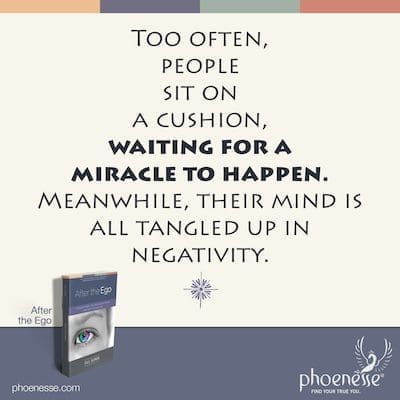
Making choices
Let’s go back to the conscious mind we have access to right now. It has the ability to observe the self—or a split off aspect of the self—and it has choices. And the attitude we choose towards our undesirable, undeveloped traits will make a difference. It’s key to our expansion.
Awakening, or expanding our consciousness, is often believed to be a magical process that happens suddenly. It is not. The only way to wake up—to attain true spiritual consciousness—is to pay attention to the material in us that is currently not being fully realized. Every moment we are depressed or anxious, every time we feel hopeless or any other negative attitude about a situation, we have options.
But it will require an inner act of will on our part to awaken the sleeping forces and get them moving. When we use the available potential we have available to us to do this, a much greater power unfolds. This happens gradually and organically. Too often, people sit on a cushion or go through some other spiritual practice, waiting for a miracle to happen. Meanwhile, their mind is all tangled up in negativity. We’ll either feel disappointed or disillusioned. But here’s the truth: No exercise, effort or hope for grace will ever bring us genuine awareness, or make our Real Self manifest.
There is tremendous power in our thoughts. Most of us underestimate what we can do with this creative energy. As such, we neglect the power we hold to recreate a better life for ourselves. To make use of this power is challenging, but it is also a fascinating adventure. Right now, we can begin to explore the far recesses of our conscious mind, searching for new and better ways to meet our difficulties. What would be a more constructive way of reacting? We are not required to react the way we do. Each of us have many thoughts and therefore many possibilities at our disposal. We can aim toward a new goal.
If we resist observing ourselves and shifting our identification, we will remain identified with what we hate most in ourselves. To the degree this is the case, we won’t be able to access new options. But if we can pose this question to ourselves, “What attitude do I want to take towards what I observe in me that I don’t like?” we will have made great strides.
Actually, knowing we can change our attitude is one of the most significant discoveries we can make at this phase of our spiritual journey. And it doesn’t require a grand revelation from our Real Self. It simply means we’re using what we’ve got to work with that, incidentally, we have made available to ourselves over the course of all the millennia we have been evolving.
What are our choices regarding our stance about what we observe? We can continue to be completely dismayed and hopeless, thinking it’s impossible to change and ever be different—that this really is all there is to us. By the way, this is what we’ve been doing up until now, only without awareness. Or we could go in the equally wrong but opposite direction, imagining we have the power to make drastic changes overnight. This is no better or positive since it will inevitably also lead to disappointment, but with an added kick of justified negativity. Both unrealistic hopelessness and unrealistic magical hope are extremes, and each leads to a vicious circle that can never land us in our Real Self.
So are those the only options? Can’t our mind come up with anything else? How about something like this: “Chances are good that as I go along, I will forget and get lost in blindness again. It’s a conditioned reflex, but that doesn’t mean this has to derail me. I am going to need to struggle again and again to find my way, groping for the key. I can do this, and I will do this. Gradually, I will get stronger and I will discover new energy and resources I didn’t have before.
“I won’t be deterred by the fact that it takes time to build something beautiful. I will have patience with myself, and I will not childishly expect all my work to be done at once. My choice is to use all my powers to do this work, but I will also be realistic. I would like my Real Self to guide me. But if I can’t yet hear what it is telling me—because starting out my energies may be too dense and my consciousness too dulled—I will trust and I will wait, and I won’t give up.
“I want to give my best to this thing we call life. Over and over, I will try to observe what I don’t like, and spell it out. That way I can identify it more easily in the future and not be identified with it. I will search for ways to understand everything I uncover. Eventually I will be able to grow out of it.”
We have the option to choose an attitude like this. This isn’t magic. It’s a choice, and we can make it, starting now. In every dilemma, we have the option to observe and identify, instead of being submerged and lost. Knowledge already exists in us which we can bring to bear on whatever we find. Using the knowledge we have access to now will broaden the scope of what we can know and feel.
The more we do this, the more expanded we become. We will integrate our split-off aspects into the universal life force and we will become it. This happens best by opening up a three-way inner dialogue. The conscious self, or ego, must speak with the demonic aspects, or Lower Self, as well as with the divine self, or Higher Self. This allows the Higher Self to communicate directly with the Lower Self. Like any meaningful conversation, both sides can speak along any of these three pathways.
It may take some time on our spiritual path before we are ready to enter into such a dialog. But by observing ourselves, we set the wheels in motion for this to take place, as our Real Self—currently made up of both our Lower Self and our Higher Self—emerges. When we can hear these inner voices working together to uncover the truth, then we will know that this is who we really are. This is where our true power lies. In this place, there is nothing to fear.
“My friends, this lecture also requires diligent attention. Much of the material cannot be taken in at first because it is difficult. It requires you to concentrate your mind and use your good will, and also contact through meditation higher realms of spiritual reality and power to help you absorb and put to use what I have said.”
–The Pathwork Guide
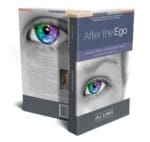
Next Chapter
Return to After the Ego Contents
Read Original Pathwork Lecture #189: Self-Identification Determined Through Stages of Consciousness

